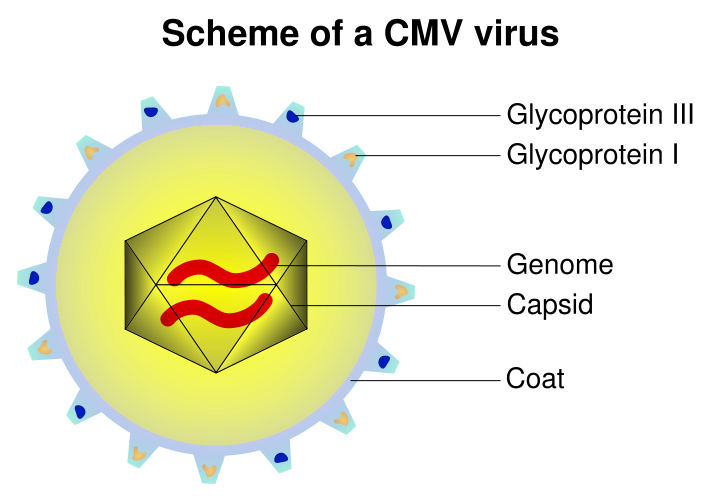Cytomegalovirus infection pathophysiology: Difference between revisions
(Created page with "__NOTOC__ {{Cytomegalovirus infection}} {{CMG}} ==Overview== ==Pathophysiology== ===Genetics=== As a result of efforts to create an attenuated virus vaccine, there cu...") |
No edit summary |
||
| Line 1: | Line 1: | ||
==Overview== | ==Overview== | ||
Revision as of 15:30, 11 August 2015
Overview
Pathophysiology
Genetics
As a result of efforts to create an attenuated virus vaccine, there currently exist two general classes of CMV.
- Clinical isolates comprise those viruses obtained from patients and represent the wild type viral genome.
- Laboratory strains have been cultured extensively in the lab setting and typically contain numerous accumulated mutations. Most notably, the laboratory strain AD169 appears to lack a 15kb region of the 200kb genome that is present in clinical isolates. This region contains 19 open reading frames whose functions have yet to be elucidated. AD169 is also unique in that it is unable to enter latency and nearly always assumes lytic growth upon infection.
Species

| Name | Abv. | Host |
|---|---|---|
| Cercopithecine herpesvirus 5 | (CeHV-5) | African green monkey |
| Cercopithecine herpesvirus 8 | (CeHV-8) | Rhesus monkey |
| Human herpesvirus 5 | (HHV-5) | Humans |
| Pongine herpesvirus 4 | (PoHV-4) | ? |
| Aotine herpesvirus 1 | (AoHV-1) | (Tentative species) |
| Aotine herpesvirus 3 | (AoHV-3) | (Tentative species) |
Associated Conditions
Specific disease entities recognised in immunocompromised people with CMV infection are cytomegalovirus retinitis (inflammation of the retina, characterised by a "pizza pie appearance" on ophthalmoscopy) and cytomegalovirus colitis (inflammation of the large bowel).
Microscopic Pathology
Microscopically, CMV can be demonstrated by intranuclear inclusion bodies, which show that the virus replicates in the nucleus rather than the cytosol. These inclusion bodies stain dark pink on an H&E stain, and are also called "Owl's Eye" inclusion bodies.
Lytically replicating virus disrupts the cytoskeleton, causing massive cell enlargement, which is the source of the virus' name.
Transmission
Transmission of CMV occurs from person to person. Seroprevalence is age-dependent: 58.9% of individuals aged 6 and over are infected with CMV while 90.8% of individuals aged 80 and over are positive for CMV.[1] Infection requires close, intimate contact with a person excreting the virus in their saliva, urine, blood, tears, and semen. The shedding of virus may take place intermittently, without any detectable signs, and without causing symptoms. CMV can be sexually transmitted and can also be transmitted via breast milk, transplanted organs, and rarely from blood transfusions.
CMV is part of the association known as TORCH infections that lead to congenital abnormalities. These include Toxoplasmosis, Rubella, Herpes simplex, as well as CMV, among others. The virus can also be transmitted to the infant at delivery from contact with genital secretions or later in infancy through breast milk. However, these infections usually result in little or no clinical illness in the infant.
Although CMV is not highly contagious, it has been shown to spread in households and among young children in day care centers.[2]
References
- ↑ Staras SAS, Dollard SC, Radford KW; et al. (2006). "Seroprevalence of cytomegalovirus infection in the United States, 1988–1994". Clin Infect Dis. 43: 1143&ndash, 51. PMID 17029132.
- ↑ Ryan KJ, Ray CG (editors) (2004). Sherris Medical Microbiology (4th ed. ed.). McGraw Hill. pp. pp. 556, 566–9. ISBN 0838585299.